Community Centre Feasibility Report: Building Environment Technology
VerifiedAdded on 2023/01/17
|9
|1466
|94
Report
AI Summary
This report presents a feasibility study for a new community center, addressing key aspects of its design and construction. The report begins with an evaluation of the current proposed floor plan, highlighting its strengths in natural lighting and flexibility for future modifications, while also noting areas for improvement such as washroom placement and the lack of a dedicated meeting room. It then contrasts framed construction with load-bearing masonry, emphasizing the advantages of framed structures in terms of speed of construction, vibration resistance, design freedom, material usage, and overall economy. An option appraisal follows, comparing timber, steel, and concrete frame structures, with timber being recommended for its sustainability and local availability. The report also considers likely ground conditions and includes a foundation sketch, along with a section of the proposed frame. References and a bibliography are provided to support the analysis and findings.
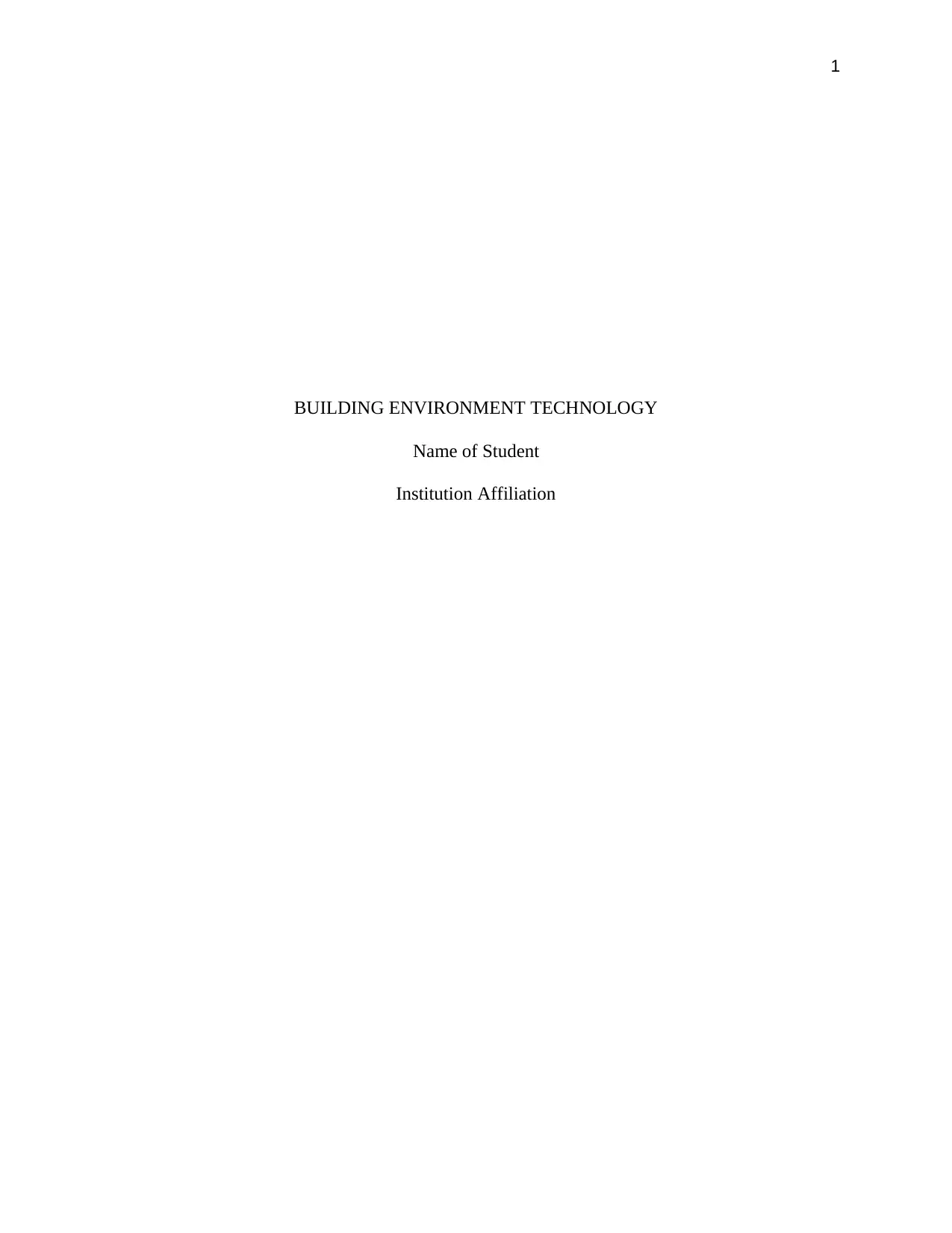
1
BUILDING ENVIRONMENT TECHNOLOGY
Name of Student
Institution Affiliation
BUILDING ENVIRONMENT TECHNOLOGY
Name of Student
Institution Affiliation
Paraphrase This Document
Need a fresh take? Get an instant paraphrase of this document with our AI Paraphraser
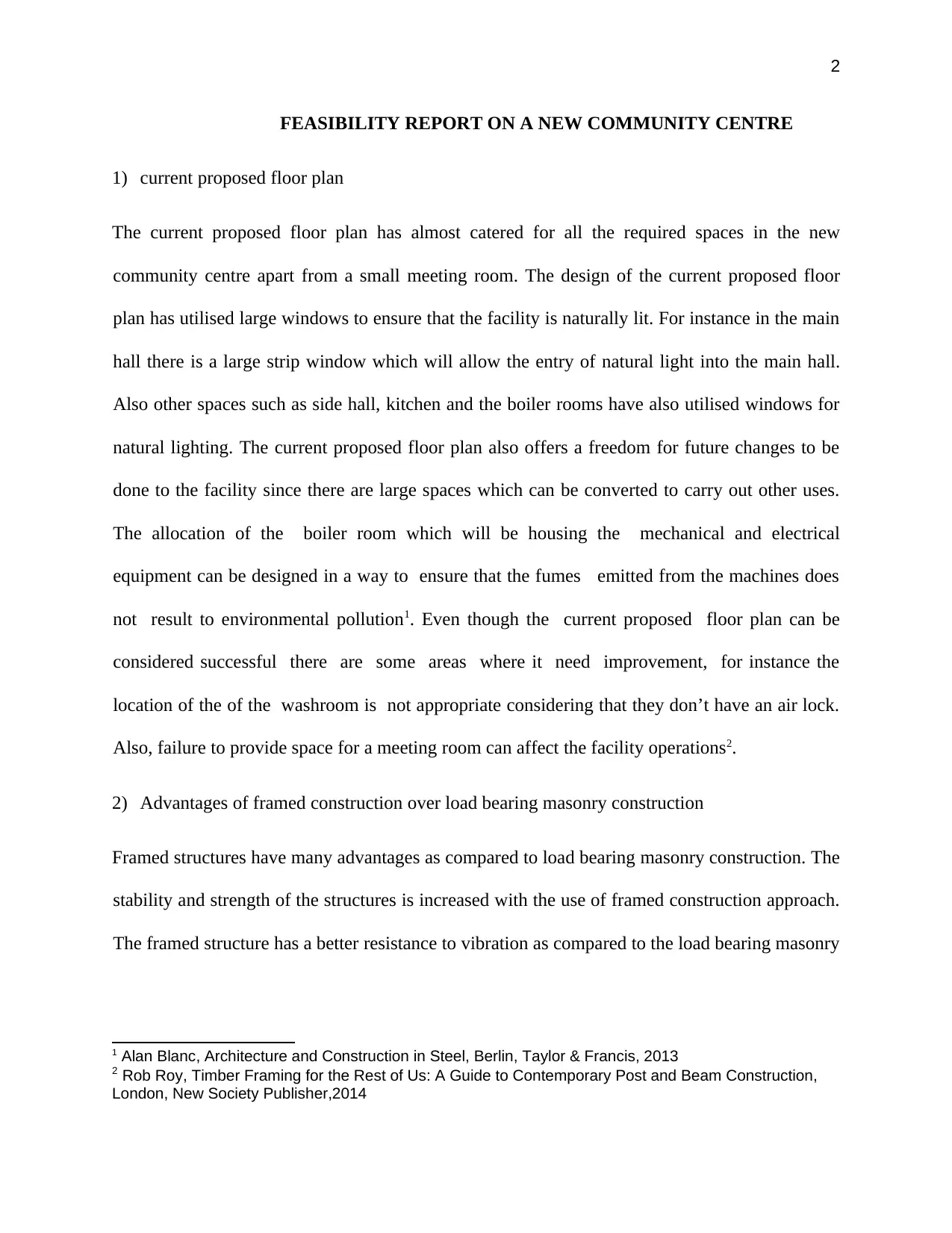
2
FEASIBILITY REPORT ON A NEW COMMUNITY CENTRE
1) current proposed floor plan
The current proposed floor plan has almost catered for all the required spaces in the new
community centre apart from a small meeting room. The design of the current proposed floor
plan has utilised large windows to ensure that the facility is naturally lit. For instance in the main
hall there is a large strip window which will allow the entry of natural light into the main hall.
Also other spaces such as side hall, kitchen and the boiler rooms have also utilised windows for
natural lighting. The current proposed floor plan also offers a freedom for future changes to be
done to the facility since there are large spaces which can be converted to carry out other uses.
The allocation of the boiler room which will be housing the mechanical and electrical
equipment can be designed in a way to ensure that the fumes emitted from the machines does
not result to environmental pollution1. Even though the current proposed floor plan can be
considered successful there are some areas where it need improvement, for instance the
location of the of the washroom is not appropriate considering that they don’t have an air lock.
Also, failure to provide space for a meeting room can affect the facility operations2.
2) Advantages of framed construction over load bearing masonry construction
Framed structures have many advantages as compared to load bearing masonry construction. The
stability and strength of the structures is increased with the use of framed construction approach.
The framed structure has a better resistance to vibration as compared to the load bearing masonry
1 Alan Blanc, Architecture and Construction in Steel, Berlin, Taylor & Francis, 2013
2 Rob Roy, Timber Framing for the Rest of Us: A Guide to Contemporary Post and Beam Construction,
London, New Society Publisher,2014
FEASIBILITY REPORT ON A NEW COMMUNITY CENTRE
1) current proposed floor plan
The current proposed floor plan has almost catered for all the required spaces in the new
community centre apart from a small meeting room. The design of the current proposed floor
plan has utilised large windows to ensure that the facility is naturally lit. For instance in the main
hall there is a large strip window which will allow the entry of natural light into the main hall.
Also other spaces such as side hall, kitchen and the boiler rooms have also utilised windows for
natural lighting. The current proposed floor plan also offers a freedom for future changes to be
done to the facility since there are large spaces which can be converted to carry out other uses.
The allocation of the boiler room which will be housing the mechanical and electrical
equipment can be designed in a way to ensure that the fumes emitted from the machines does
not result to environmental pollution1. Even though the current proposed floor plan can be
considered successful there are some areas where it need improvement, for instance the
location of the of the washroom is not appropriate considering that they don’t have an air lock.
Also, failure to provide space for a meeting room can affect the facility operations2.
2) Advantages of framed construction over load bearing masonry construction
Framed structures have many advantages as compared to load bearing masonry construction. The
stability and strength of the structures is increased with the use of framed construction approach.
The framed structure has a better resistance to vibration as compared to the load bearing masonry
1 Alan Blanc, Architecture and Construction in Steel, Berlin, Taylor & Francis, 2013
2 Rob Roy, Timber Framing for the Rest of Us: A Guide to Contemporary Post and Beam Construction,
London, New Society Publisher,2014
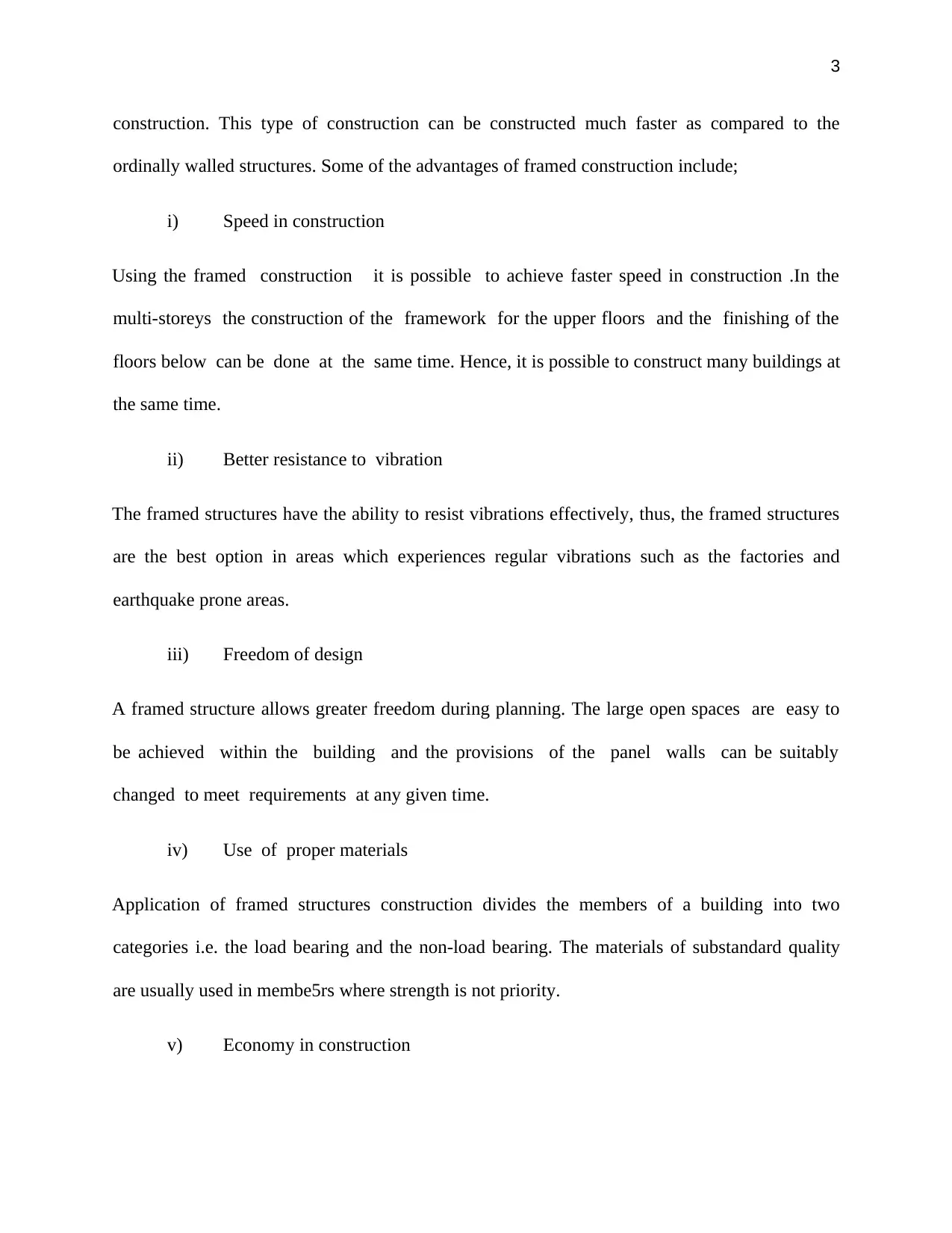
3
construction. This type of construction can be constructed much faster as compared to the
ordinally walled structures. Some of the advantages of framed construction include;
i) Speed in construction
Using the framed construction it is possible to achieve faster speed in construction .In the
multi-storeys the construction of the framework for the upper floors and the finishing of the
floors below can be done at the same time. Hence, it is possible to construct many buildings at
the same time.
ii) Better resistance to vibration
The framed structures have the ability to resist vibrations effectively, thus, the framed structures
are the best option in areas which experiences regular vibrations such as the factories and
earthquake prone areas.
iii) Freedom of design
A framed structure allows greater freedom during planning. The large open spaces are easy to
be achieved within the building and the provisions of the panel walls can be suitably
changed to meet requirements at any given time.
iv) Use of proper materials
Application of framed structures construction divides the members of a building into two
categories i.e. the load bearing and the non-load bearing. The materials of substandard quality
are usually used in membe5rs where strength is not priority.
v) Economy in construction
construction. This type of construction can be constructed much faster as compared to the
ordinally walled structures. Some of the advantages of framed construction include;
i) Speed in construction
Using the framed construction it is possible to achieve faster speed in construction .In the
multi-storeys the construction of the framework for the upper floors and the finishing of the
floors below can be done at the same time. Hence, it is possible to construct many buildings at
the same time.
ii) Better resistance to vibration
The framed structures have the ability to resist vibrations effectively, thus, the framed structures
are the best option in areas which experiences regular vibrations such as the factories and
earthquake prone areas.
iii) Freedom of design
A framed structure allows greater freedom during planning. The large open spaces are easy to
be achieved within the building and the provisions of the panel walls can be suitably
changed to meet requirements at any given time.
iv) Use of proper materials
Application of framed structures construction divides the members of a building into two
categories i.e. the load bearing and the non-load bearing. The materials of substandard quality
are usually used in membe5rs where strength is not priority.
v) Economy in construction
⊘ This is a preview!⊘
Do you want full access?
Subscribe today to unlock all pages.

Trusted by 1+ million students worldwide

4
The benefits of framed structures such as, speed construction, use of proper materials and the
freedom of design leads to overall economy in the construction of a structure. This the reason
why framed structures are widely accepted in the modern world.
3) An option appraisal
Advantages of timber frame structures
The following are advantages associated with timber frame structures:
The timber structures are more durable and strong
Usually there are no load bearing walls in the timber frame structures, this allows for
changes to the floor plan without altering the structural members
The noise insulation of timber is remarkable3
A very low carbon footprint is generated when the local woods are used.
The construction of timber framed structures generates no wastes
There is very little or no temperature variations throughout the structure
They are locally available and hence they reduce the cost of acquiring
In timber framed structures there is much more energy efficiency
Advantages of steel frame structures
Cost effective
Usually timber is cheaper than steel as a construction material, but at the same time steel can
be easier and lighter to assemble, due to that steel will be considered to be cost effective
during the construction stages.
Stronger and straight
3 Sidney Levy, Construction Databook,London, McGraw-Hill,2016
The benefits of framed structures such as, speed construction, use of proper materials and the
freedom of design leads to overall economy in the construction of a structure. This the reason
why framed structures are widely accepted in the modern world.
3) An option appraisal
Advantages of timber frame structures
The following are advantages associated with timber frame structures:
The timber structures are more durable and strong
Usually there are no load bearing walls in the timber frame structures, this allows for
changes to the floor plan without altering the structural members
The noise insulation of timber is remarkable3
A very low carbon footprint is generated when the local woods are used.
The construction of timber framed structures generates no wastes
There is very little or no temperature variations throughout the structure
They are locally available and hence they reduce the cost of acquiring
In timber framed structures there is much more energy efficiency
Advantages of steel frame structures
Cost effective
Usually timber is cheaper than steel as a construction material, but at the same time steel can
be easier and lighter to assemble, due to that steel will be considered to be cost effective
during the construction stages.
Stronger and straight
3 Sidney Levy, Construction Databook,London, McGraw-Hill,2016
Paraphrase This Document
Need a fresh take? Get an instant paraphrase of this document with our AI Paraphraser

5
When steel is used a structure framing material it gives a straighter finish, particularly, along the
ceiling, roof lines and the walls. At the same time steel provides stronger foundations preventing
sloping and sinking of a structure4.
Fire resistance
The timber framed structures are prone to fire, but steel is non-combustible and it does not bend
or warp in fire5.
Termite proof
When steel is used as a framing material it is usually termite proof unlike timber.
Advantages of concrete frame structures
Below are some of the advantages of using concrete as a framing material for concrete frame
structures:
Concrete has high compressive strength as compared to other construction materials such as
timber
The weather and fire resistance of concrete is fair
The maintenance cost of concrete is manageable
It acts as a rigid member with very low deflection
The reinforced concrete buildings more durable as compared to other building systems.
4 Gerry Shaw, Structural Masonry Designers' Manual, London, John Wiley & Sons, 2017
5 Josef Kolb, Systems in Timber Engineering: Loadbearing Structures and Component Layers,
Berlin, Springer Science & Business Media,2018
When steel is used a structure framing material it gives a straighter finish, particularly, along the
ceiling, roof lines and the walls. At the same time steel provides stronger foundations preventing
sloping and sinking of a structure4.
Fire resistance
The timber framed structures are prone to fire, but steel is non-combustible and it does not bend
or warp in fire5.
Termite proof
When steel is used as a framing material it is usually termite proof unlike timber.
Advantages of concrete frame structures
Below are some of the advantages of using concrete as a framing material for concrete frame
structures:
Concrete has high compressive strength as compared to other construction materials such as
timber
The weather and fire resistance of concrete is fair
The maintenance cost of concrete is manageable
It acts as a rigid member with very low deflection
The reinforced concrete buildings more durable as compared to other building systems.
4 Gerry Shaw, Structural Masonry Designers' Manual, London, John Wiley & Sons, 2017
5 Josef Kolb, Systems in Timber Engineering: Loadbearing Structures and Component Layers,
Berlin, Springer Science & Business Media,2018

6
Timber will be the most appropriate material to be used for framing. By considering the
sustainability aspects of the facility. Timber is locally available and it has a minimal carbon
footprint as compared to the other materials6.
4) likely ground conditions
The likely site condition is that the ground will be stable to accommodate the weight of the
structure. Since much of the site lies on a very hard basement of rocks, which either form the
surface or are covered by a thin layer of soil. Below is raft foundation for timber frame
construction:
Fig: foundation sketch
5) Section of the proposed frame
6 Edward Allen, Fundamentals of Residential Construction, Chicago, John Wiley & Sons, 2017
Timber will be the most appropriate material to be used for framing. By considering the
sustainability aspects of the facility. Timber is locally available and it has a minimal carbon
footprint as compared to the other materials6.
4) likely ground conditions
The likely site condition is that the ground will be stable to accommodate the weight of the
structure. Since much of the site lies on a very hard basement of rocks, which either form the
surface or are covered by a thin layer of soil. Below is raft foundation for timber frame
construction:
Fig: foundation sketch
5) Section of the proposed frame
6 Edward Allen, Fundamentals of Residential Construction, Chicago, John Wiley & Sons, 2017
⊘ This is a preview!⊘
Do you want full access?
Subscribe today to unlock all pages.

Trusted by 1+ million students worldwide
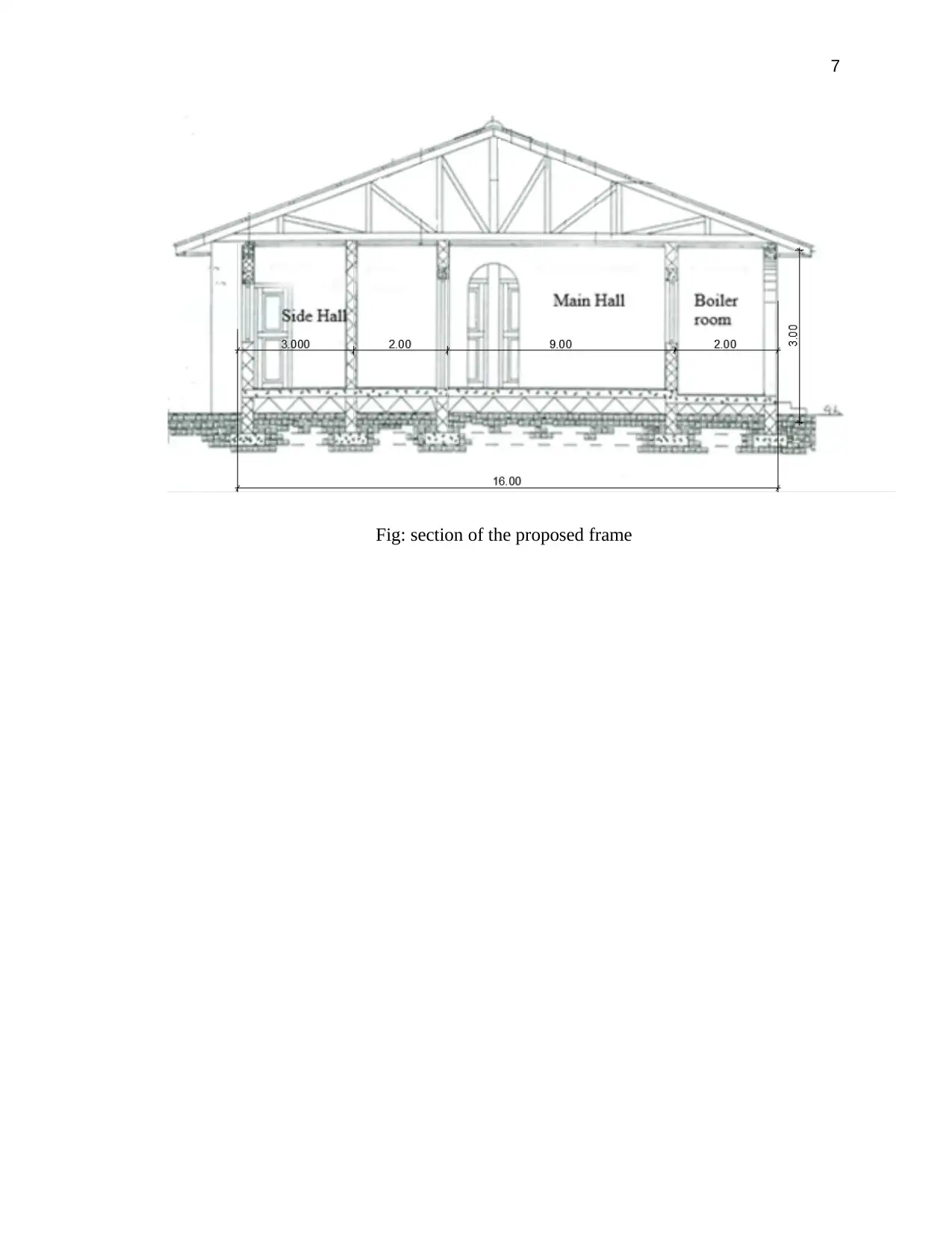
7
Fig: section of the proposed frame
Fig: section of the proposed frame
Paraphrase This Document
Need a fresh take? Get an instant paraphrase of this document with our AI Paraphraser
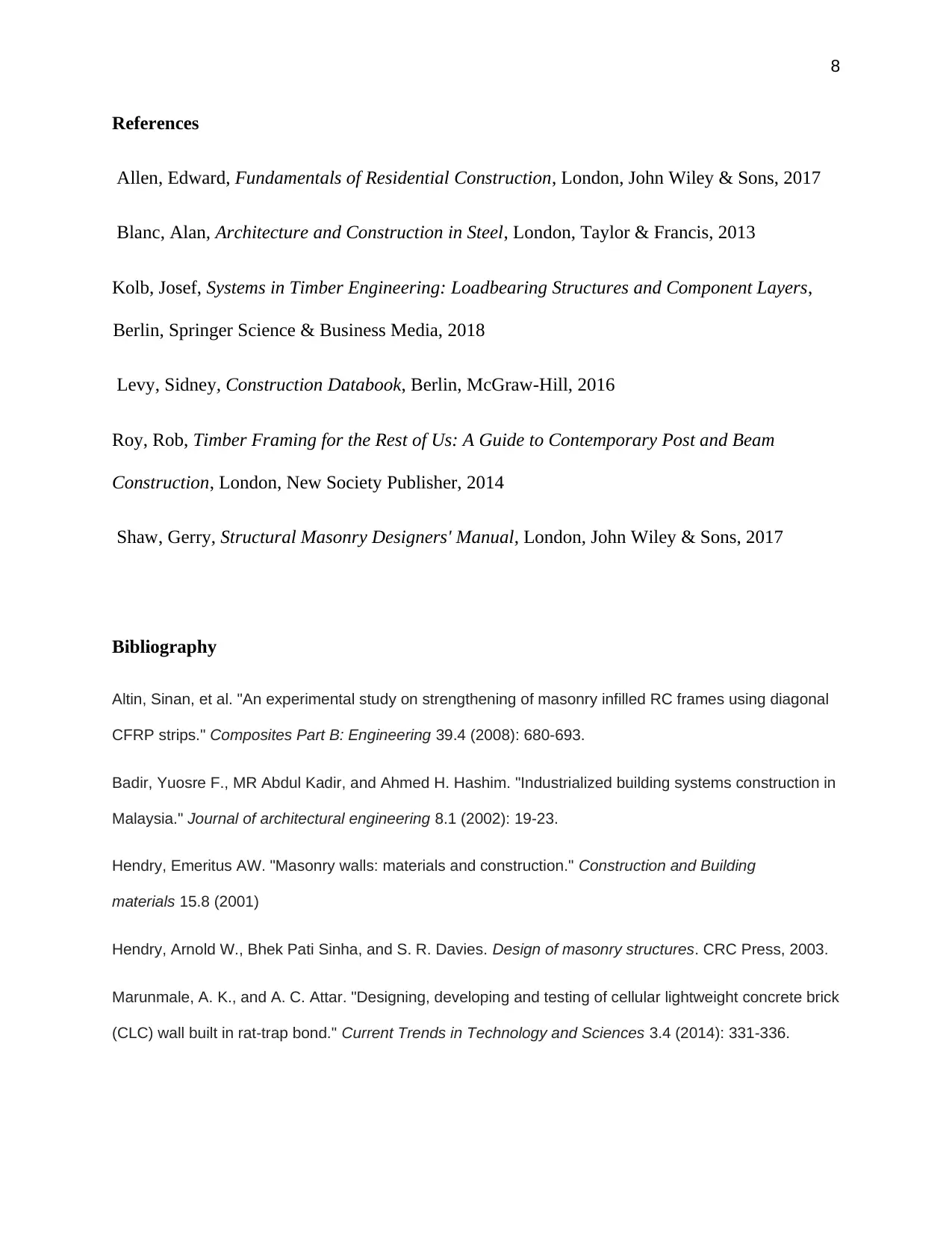
8
References
Allen, Edward, Fundamentals of Residential Construction, London, John Wiley & Sons, 2017
Blanc, Alan, Architecture and Construction in Steel, London, Taylor & Francis, 2013
Kolb, Josef, Systems in Timber Engineering: Loadbearing Structures and Component Layers,
Berlin, Springer Science & Business Media, 2018
Levy, Sidney, Construction Databook, Berlin, McGraw-Hill, 2016
Roy, Rob, Timber Framing for the Rest of Us: A Guide to Contemporary Post and Beam
Construction, London, New Society Publisher, 2014
Shaw, Gerry, Structural Masonry Designers' Manual, London, John Wiley & Sons, 2017
Bibliography
Altin, Sinan, et al. "An experimental study on strengthening of masonry infilled RC frames using diagonal
CFRP strips." Composites Part B: Engineering 39.4 (2008): 680-693.
Badir, Yuosre F., MR Abdul Kadir, and Ahmed H. Hashim. "Industrialized building systems construction in
Malaysia." Journal of architectural engineering 8.1 (2002): 19-23.
Hendry, Emeritus AW. "Masonry walls: materials and construction." Construction and Building
materials 15.8 (2001)
Hendry, Arnold W., Bhek Pati Sinha, and S. R. Davies. Design of masonry structures. CRC Press, 2003.
Marunmale, A. K., and A. C. Attar. "Designing, developing and testing of cellular lightweight concrete brick
(CLC) wall built in rat-trap bond." Current Trends in Technology and Sciences 3.4 (2014): 331-336.
References
Allen, Edward, Fundamentals of Residential Construction, London, John Wiley & Sons, 2017
Blanc, Alan, Architecture and Construction in Steel, London, Taylor & Francis, 2013
Kolb, Josef, Systems in Timber Engineering: Loadbearing Structures and Component Layers,
Berlin, Springer Science & Business Media, 2018
Levy, Sidney, Construction Databook, Berlin, McGraw-Hill, 2016
Roy, Rob, Timber Framing for the Rest of Us: A Guide to Contemporary Post and Beam
Construction, London, New Society Publisher, 2014
Shaw, Gerry, Structural Masonry Designers' Manual, London, John Wiley & Sons, 2017
Bibliography
Altin, Sinan, et al. "An experimental study on strengthening of masonry infilled RC frames using diagonal
CFRP strips." Composites Part B: Engineering 39.4 (2008): 680-693.
Badir, Yuosre F., MR Abdul Kadir, and Ahmed H. Hashim. "Industrialized building systems construction in
Malaysia." Journal of architectural engineering 8.1 (2002): 19-23.
Hendry, Emeritus AW. "Masonry walls: materials and construction." Construction and Building
materials 15.8 (2001)
Hendry, Arnold W., Bhek Pati Sinha, and S. R. Davies. Design of masonry structures. CRC Press, 2003.
Marunmale, A. K., and A. C. Attar. "Designing, developing and testing of cellular lightweight concrete brick
(CLC) wall built in rat-trap bond." Current Trends in Technology and Sciences 3.4 (2014): 331-336.

9
Sinha, Braj P. "Development and potential of structural masonry." Ponencia en el Seminario sobre
paredes de albañilería, Lourenco y Souza, Porto, Portugal (2002).
Sinha, Braj P. "Development and potential of structural masonry." Ponencia en el Seminario sobre
paredes de albañilería, Lourenco y Souza, Porto, Portugal (2002).
⊘ This is a preview!⊘
Do you want full access?
Subscribe today to unlock all pages.

Trusted by 1+ million students worldwide
1 out of 9
Related Documents
Your All-in-One AI-Powered Toolkit for Academic Success.
+13062052269
info@desklib.com
Available 24*7 on WhatsApp / Email
![[object Object]](/_next/static/media/star-bottom.7253800d.svg)
Unlock your academic potential
Copyright © 2020–2025 A2Z Services. All Rights Reserved. Developed and managed by ZUCOL.





